
Cheat Sheet to Choosing the Best Board Bodyboard for You
Why the Board Bodyboard Revolution Started in 1971 and Never Stopped
A board bodyboard is a foam board designed for riding waves while lying prone or on one knee, invented by Tom Morey in Hawaii in 1971. Here's what makes bodyboards different from surfboards:
Key Differences:
- Length: 36-46 inches vs 6-10 feet for surfboards
- Riding position: Prone or drop-knee vs standing
- Learning curve: Much easier for beginners
- Cost: $160-$400 vs $300-$800+ for surfboards
- Wave catching: Faster due to wider planing surface
Quick Sizing Guide:
- Stand upright - board should reach your belly button
- 36" board: 40-90 lbs riders
- 42" board: 145-180 lbs riders
- 46" board: 220+ lbs riders
What started as Tom Morey's simple polyethylene foam creation has evolved into high-tech boards with carbon fiber stringers, multiple channels, and specialized cores. The "boogie board" name stuck from the original Morey Boogie brand, but modern bodyboards are far more advanced than those early foam planks.
The belly-button rule remains the gold standard for sizing - a properly fitted board bodyboard should reach your navel when you stand it upright next to you. This simple test accounts for your torso length and ensures optimal control and buoyancy.
As specialists from American Mortuary Coolers, we've spent years understanding how proper sizing and material selection impact performance - whether it's cooling systems or wave-riding equipment. Our experience with precision engineering in the mortuary industry has given us unique insights into how board bodyboard construction and fit directly affect user satisfaction and safety.
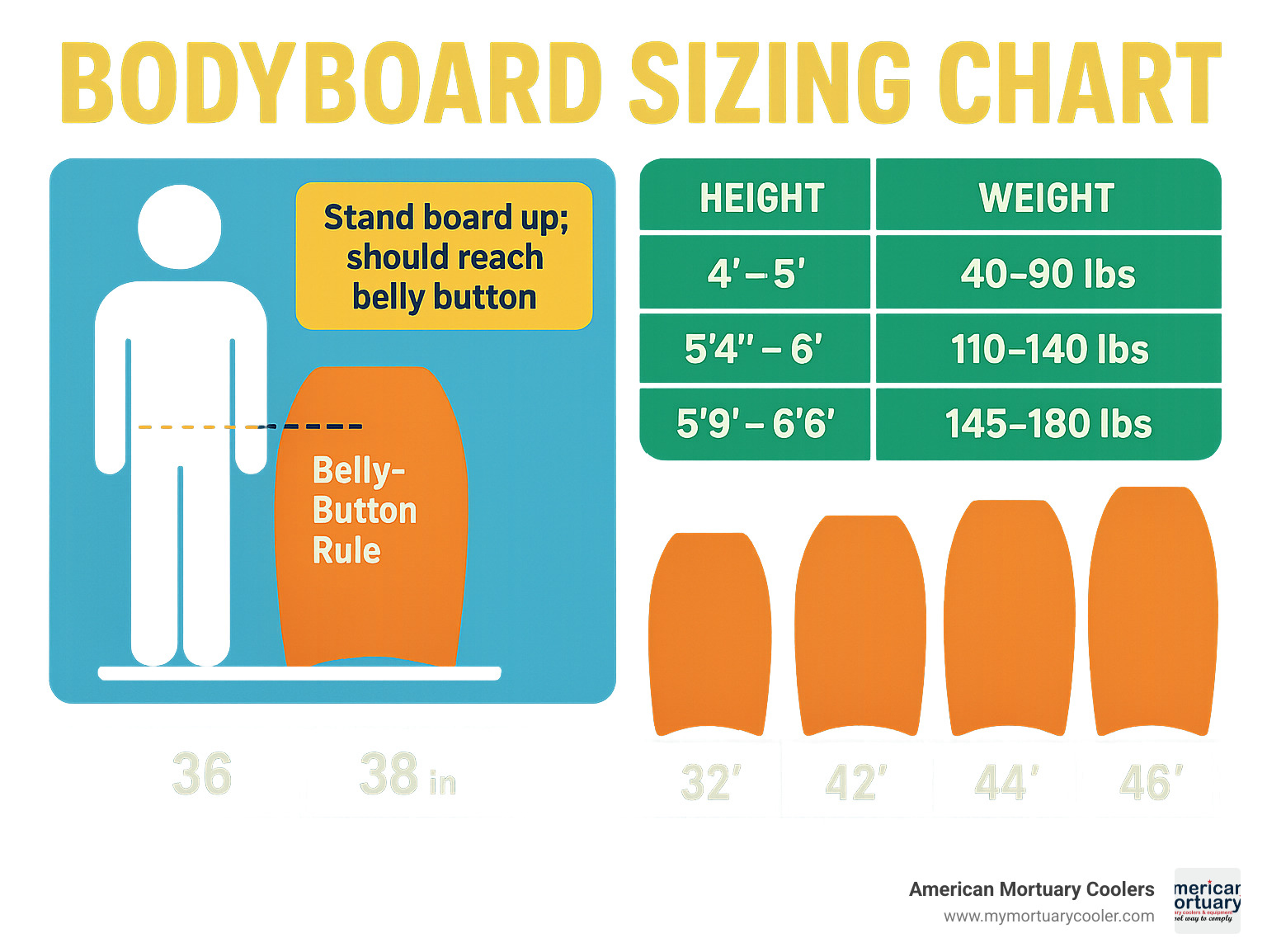
Board Bodyboard 101: What It Is & How It Differs From a Surfboard
Think of a board bodyboard as surfing's more approachable cousin. While surfboards are built with hard fiberglass shells over foam cores, bodyboards accept a completely different philosophy with their soft foam construction and slick plastic bottom that glides effortlessly across the water.
The magic happens in how you ride them. Instead of standing up like a surfer, you'll be lying prone on your stomach or riding drop-knee style with one knee planted on the deck. This lower position might look less dramatic, but it's actually your secret weapon for stability and control.
At just 36-46 inches long, bodyboards are practically pocket-sized compared to surfboards that stretch 6-10 feet. This compact size makes them incredibly easy to carry under your arm, toss in the car, or store in your garage without taking over the entire space.
The buoyancy focus is totally different too. While surfboards need to support your entire standing body weight, bodyboards are designed to float your torso while your legs and fins do the work behind you. It's like having a personal flotation device that also happens to catch waves.
Here's where it gets really appealing: cost. Quality bodyboards typically range from $160-$400, while surfboards often start at $300 and can easily hit $800 or more for premium models. For families or beginners testing the waters, that price difference is huge.
The learning curve is dramatically easier with bodyboards. Most people can catch their first wave within their first session, compared to surfboards where just standing up can take weeks of practice.
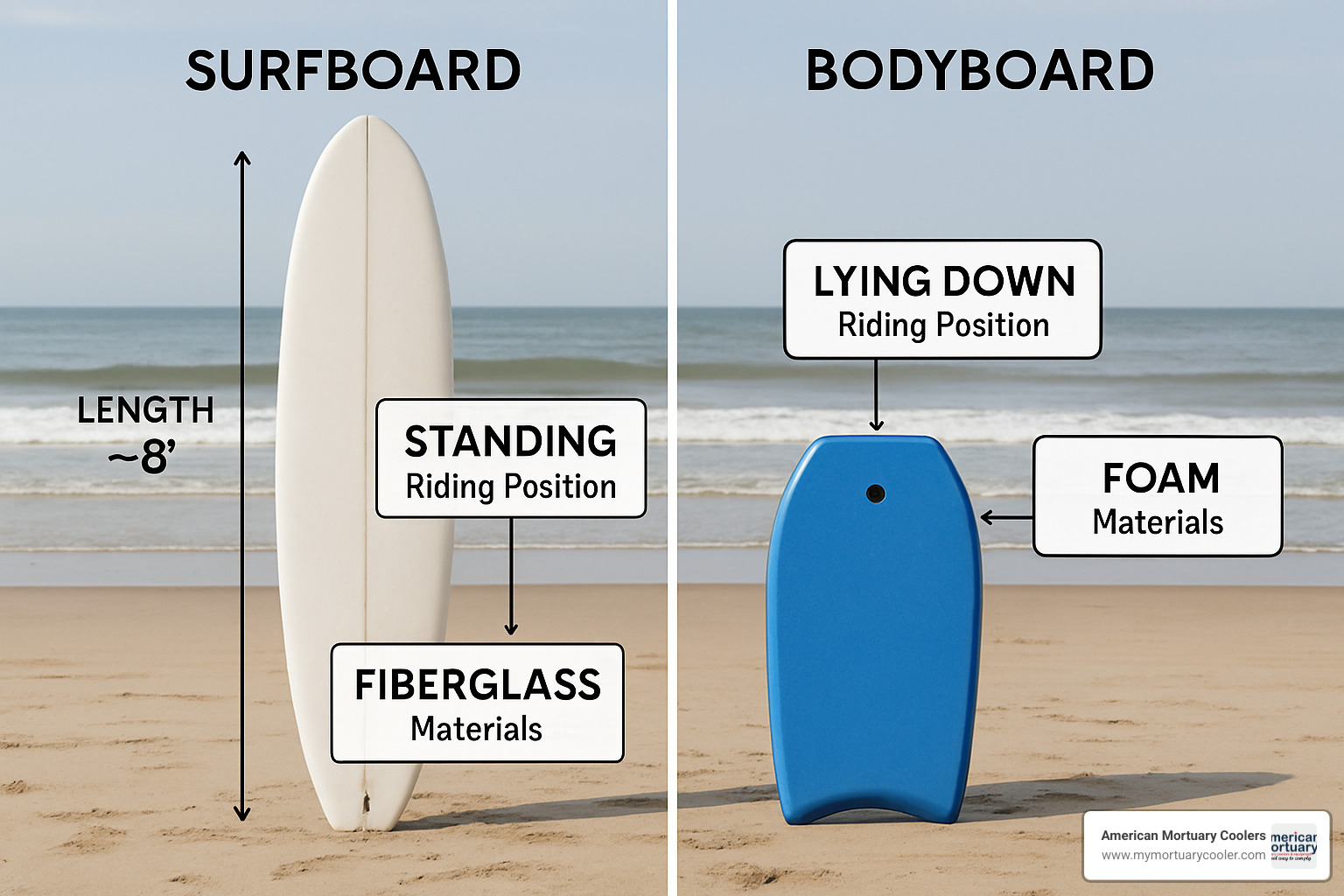
Why a Board Bodyboard Catches Waves Faster
The board bodyboard is basically a wave-catching machine, and there's real science behind why it works so well. The wide nose creates a massive planing surface that helps you get up and riding almost instantly when a wave approaches.
Your lower center of gravity from lying prone means less drag cutting through the water. Think about it - you're streamlined like a torpedo instead of standing upright like a sail catching wind resistance.
The easier kick-in comes from the perfect partnership between your swim fins and the board's responsive design. When you spot an incoming wave, just a few powerful kicks can launch you into the wave zone faster than surfers can paddle from their standing position.
That wide template and foam construction provide incredible buoyancy per square inch. This means you can catch waves that might be too small or weak for surfboards, making every surf session more productive.
The fins assist by giving you instant propulsion - no waiting around hoping you've got enough paddle power. You see a wave, you kick, you're riding. It's that simple.
As specialists in precision equipment at American Mortuary Coolers, we appreciate how thoughtful design makes all the difference in performance. The same attention to detail that goes into our cooling systems applies to understanding why bodyboards work so effectively for wave riding.
Dialing-In Size, Shape & Volume
Getting the right size board bodyboard is like finding the perfect fit for any precision equipment - it makes all the difference in performance and enjoyment. While the traditional sizing chart is a great starting point, modern bodyboarding has evolved to consider volume and buoyancy as equally important factors.
The standard approach matches board length to your height and weight. A 36-inch board works well for riders weighing 40-90 lbs and standing 4' to 4'10" tall, while a 42-inch board suits riders between 145-180 lbs and 5'7" to 6'0" in height. The largest standard boards at 46 inches are designed for riders over 220 lbs and 6'4" tall.
But here's where it gets interesting - width and thickness determine your board's volume and buoyancy characteristics. Think of it like choosing the right cooling capacity for different sized spaces. High-volume boards are specifically engineered for riders over 180 lbs, providing that extra width and thickness needed to maintain proper flotation and performance.
Kids need boards that match their smaller frames and developing skills. Children's bodyboards are typically less stiff than adult versions, making it easier for young riders to initiate turns, duck dive, and master fundamental techniques without fighting their equipment.
For larger riders, specialized options like the BullyBoard Buffalo model accommodate riders over 400 lbs and can even support two adults. At 57" x 34" x 3-3/4", it's built for serious buoyancy and durability.
| Height | Weight | Board Length |
|---|---|---|
| 4'-4'10" | 40-90 lbs | 36" |
| 4'10"-5'2" | 90-120 lbs | 38" |
| 5'2"-5'7" | 120-145 lbs | 40" |
| 5'7"-6'0" | 145-180 lbs | 42" |
| 6'0"-6'4" | 180-220 lbs | 44" |
| 6'4"+ | 220+ lbs | 46" |
How to Size Your Board Bodyboard Correctly
The belly-button test remains your most reliable sizing method for any board bodyboard. Stand the board upright next to you - it should reach your navel. This simple test accounts for your torso length and ensures optimal control in the water.
Don't get too hung up on standard size charts if you're already happy with your current board. Some riders have longer legs or shorter torsos, which naturally shifts the ideal sizing recommendations. Your body proportions matter more than generic guidelines.
For riders over 180 lbs, high-volume models become essential. These boards provide the extra width and thickness needed to maintain buoyancy and help you plane smoothly through dead spots between waves. The Science Pro Tech, priced at $166, offers excellent value as an entry-level high-performance board with two stringers and dual slotted channels.
Wave type also influences sizing decisions. Smaller, weaker waves benefit from slightly longer boards for better paddle power, while powerful waves allow for shorter, more maneuverable options.
Common sizing mistakes include choosing too small a board to look "professional," ignoring weight when focusing only on height, not considering wave conditions, buying based on price alone, and overlooking volume needs for heavier riders. These mistakes can turn a fun session into a frustrating struggle against your equipment.
Understanding Board Bodyboard Shapes & Tails
The tail shape of your board bodyboard dramatically affects how it performs in the water. Just like how different cooling system designs serve different purposes, tail shapes are engineered for specific performance characteristics.
Crescent tails feature that distinctive curved cutout that provides excellent hold in the wave face and responsive turning. They're perfect for carving and precision maneuvers, giving you that locked-in feeling when the wave gets steep. The trade-off is slightly less straight-line speed compared to other designs.
Bat tails take a different approach with their wider, more angular design that maximizes planing surface and speed. They excel in powerful waves and provide more drive through flat sections, making them ideal for riders who prioritize speed and projection. However, they may feel less responsive in tight, technical turns.
Quad-bat tails offer the best of both worlds, combining elements of crescent and bat tail designs for versatility across different wave conditions. They're increasingly popular among riders who want one board that performs well in various situations.
The channels molded into the bottom of your board also play a crucial role. Single channels provide maximum speed and drive, while multiple channels offer more control and maneuverability. The rails (edges) can be sharp for precision control or rounded for a more forgiving feel.
The overall template - your board's outline shape - affects how it performs in different wave types. Wider templates provide more paddle power and stability, while narrower designs offer increased maneuverability and responsiveness.
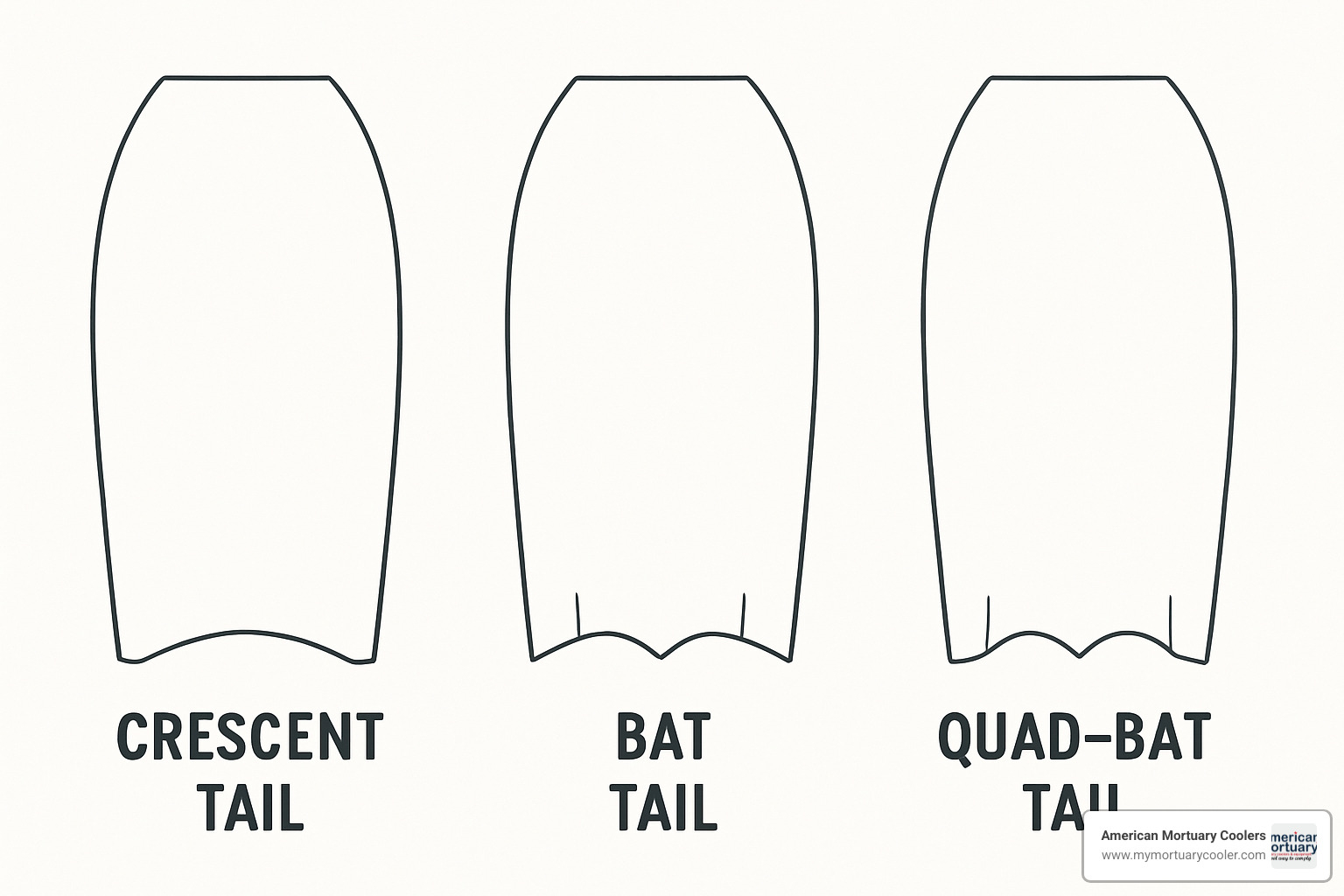
Inside the Core: Materials, Stringers & Tech That Matter
When you're choosing a board bodyboard, the core material makes all the difference in how it feels under your body and responds to waves. Think of it like choosing the right insulation for temperature control - each material has its sweet spot.
The three main core types each have their personality. PE (polyethylene) cores are the workhorses of bodyboarding - they flex nicely and handle temperature changes well, making them perfect for most riders and conditions. PP (polypropylene) cores are the high-performance option, offering stiffer response that advanced riders love in warmer water. EPS (expanded polystyrene) cores are the budget-friendly choice, lighter on your wallet but not as durable for serious sessions.
The slick bottom is where the magic happens when you're flying across wave faces. Most boards use HDPE (high-density polyethylene), which works great for everyday riding. Premium boards feature Surlyn bottoms - they're faster and last longer, though you'll pay more upfront. The newest innovation is ALPHAFLEX technology, which actually eliminates traditional stringers while keeping the board strong and responsive.
Stringers are like the spine of your board bodyboard - they give it structure and prevent it from folding in half during heavy sessions. The legendary Morey Mach 10, first launched in 1984, changed everything by introducing fiberglass and graphite stringers to bodyboards. Before that, boards were pretty basic foam planks.
Modern quality boards typically have one to three stringers made from fiberglass, carbon fiber, or composite blends. More stringers generally mean more durability and better performance, especially if you're a bigger rider or planning to charge heavy waves. The NMD Ben Player Quad showcases cutting-edge ALPHAFLEX core technology that ditches traditional tubular stringers entirely while actually boosting both durability and performance.
Don't overlook deck construction either. Basic foam decks work fine for casual riding, but advanced boards feature mesh reinforcement and composite materials that improve grip and comfort during long sessions. The deck is where your body meets the board, so quality here really matters.
At American Mortuary Coolers, we understand how material choice affects longevity and performance - whether we're building custom cooling systems or analyzing wave-riding equipment. Scientific research on polymer flex retention shows how different foam compositions maintain their properties over time, which directly impacts how your board will feel after hundreds of sessions.
For riders serious about performance, checking out options like the Science Pro Tech external review can help you understand how modern construction techniques translate to real-world wave riding. The technology has come incredibly far since Tom Morey's first foam creation in 1971.
Gear Up: Accessories, Care & Repairs
Your board bodyboard is just the beginning of your wave-riding trip. The right accessories can transform a good session into an unforgettable one, while proper care keeps your board performing like new for years to come.
Swim fins are absolutely non-negotiable. Without them, you'll struggle to catch waves and feel like you're swimming through molasses. Good fins provide the thrust you need to match wave speed and give you the control to carve and maneuver once you're riding.
A quality leash saves both your board and your relationships with other surfers. Nothing ruins the vibe faster than a runaway board bonking someone on the head. Choose a leash that matches your board length and feels comfortable on your wrist or bicep - you'll forget it's there until you need it.
Wetsuits are game-changers for extending your sessions. They keep you warm in cold water and protect your skin from sun damage and reef scrapes. Even in warm water, a thin wetsuit can prevent that painful chest rash from sliding on the deck all day.
Board bags might seem like an unnecessary expense, but they're insurance for your investment. UV rays are foam's worst enemy, and a good bag prevents sun damage during transport and storage. Plus, it keeps your car clean and protects your board from dings.
Unlike surfboards, most bodyboards don't need wax thanks to their grippy foam decks. However, some riders like a light coat for extra traction in the chest area. Fin socks prevent painful blisters during marathon sessions and help your fins fit more snugly.
Taking care of your board is surprisingly simple. Rinse it with fresh water after every session to remove salt and sand. Store it somewhere cool and dry - never leave it baking in your car or on hot sand. The foam will literally cook and become brittle.
Small dings happen, but they're easy to fix with basic patch kits. Catch them early before water seeps into the core and causes bigger problems. For major damage or delamination, take it to a professional repair shop.
At American Mortuary Coolers, we know a thing or two about keeping things properly preserved. Just like our cooling systems maintain optimal conditions for our clients, your bodyboard needs the right environment to stay in peak condition. Cool, dry storage isn't just good advice for body cooling systems - it's essential for foam boards too.
The key is consistency. Make rinsing and proper storage part of your post-session routine, and your board bodyboard will reward you with years of reliable performance.
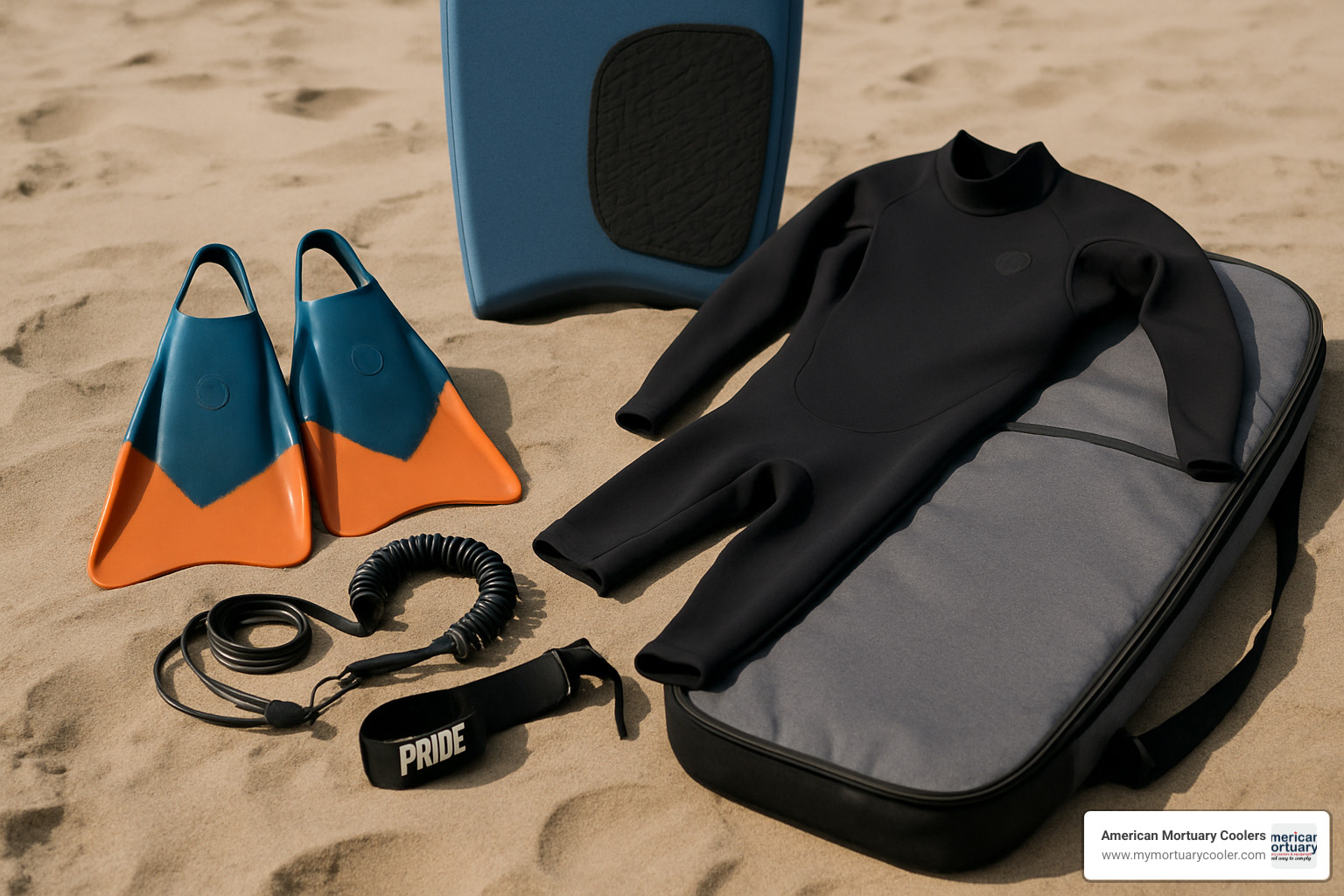
2024 Buying Guide, Trends & Dream Spots
The board bodyboard market in 2024 is absolutely buzzing with innovation. Whether you're just starting out or you're ready to upgrade to a high-performance machine, there's never been a better time to find your perfect wave-riding companion.
Let's start with the cream of the crop. The Morey Mach 10 at $200 remains the go-to choice for drop-knee enthusiasts who want that classic feel. Its narrow template and responsive turning ability make it a joy to ride, while those distinctive nose bulbs provide rock-solid grip during prone rides.
For newcomers looking for serious value, the Science Pro Tech at $166 is tough to beat. This board delivers premium performance without the premium price tag, thanks to its two stringers and dual slotted channels. The curved shape absolutely excels at carving sections and gives you the confidence to try aerial maneuvers as your skills progress.
Moving up the performance ladder, the Science Eleven LTD TriQuad at $333 brings advanced channel configuration that gives you incredible rail-to-rail control and speed. It's the kind of board that grows with you as your riding improves.
The Pride The Guru Radial FLEX SDC at $379 offers versatile all-around performance that's been refined based on professional rider feedback. This board handles everything from small beach breaks to overhead barrels with equal confidence.
At the top end, the NMD Ben Player Quad at $400 showcases cutting-edge ALPHAFLEX core technology. This innovation eliminates traditional stringers while actually improving durability and performance - it's engineering at its finest.
For warm water enthusiasts, the Empire BOTHA PP+ at $334 features a polypropylene core that comes alive in tropical conditions. The stiffer flex pattern provides incredible responsiveness when the water temperature rises.
The Custom X JMV models at $291 give you the freedom to choose between quad bat tail and crescent tail configurations, letting you match your board to your riding style perfectly.
Current trends are pushing the envelope in exciting ways. Eco-friendly foam alternatives are becoming mainstream as manufacturers respond to environmental concerns. Quad-vent deck designs reduce weight without sacrificing strength, while advanced stringer configurations offer better flex patterns than ever before.
Most riders find their sweet spot in the $250-$300 range, though quality boards span from $160 to $400. The latest boards collection showcases just how far the technology has advanced since Tom Morey's original 1971 creation.
The competitive scene continues to drive innovation forward. Major contests like the Pipeline Bodyboard World Championships and Shark Island Challenge showcase the sport's incredible progression. The 2025 Pipeline event featured 94 competitors from around the world, with Dave Hubbard claiming the ultimate prize.
Speaking of Pipeline, it remains the dream destination for any serious bodyboarder. The Hawaiian reef break is the ultimate testing ground where legends are made. The Canary Islands offer consistent waves year-round, making them perfect for extended sessions. Australian reef breaks serve up those perfect barrels that make for epic photos, while Portugal's coast delivers powerful Atlantic swells that challenge even the most experienced riders.
At American Mortuary Coolers, we appreciate precision engineering and quality construction - whether it's in our mortuary cooling systems or in the boards that brave the world's most challenging waves. Just as we ensure our equipment performs flawlessly when it matters most, choosing the right board bodyboard can make the difference between an average session and the ride of your life.
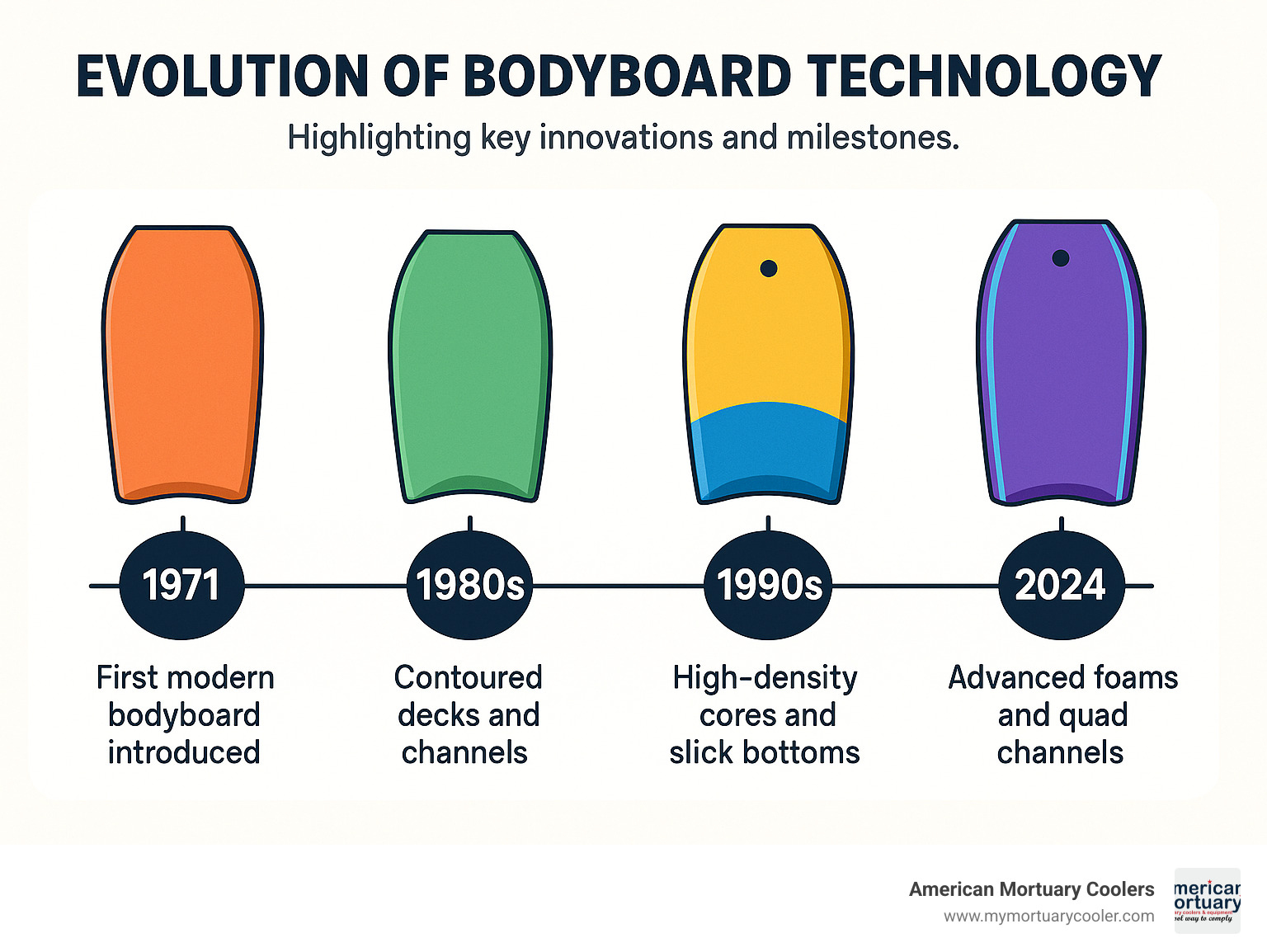
Frequently Asked Questions about Picking the Right Board Bodyboard
Choosing the right board bodyboard can feel overwhelming with so many options available. Here are the three questions we hear most often from riders trying to find their perfect match.
1. What size board should I ride if I'm between sizes?
When you're caught between two sizes, your skill level becomes the deciding factor. Beginners should always go larger - that extra buoyancy and stability will help you catch more waves and build confidence faster. The board might feel a bit cumbersome at first, but you'll appreciate the forgiveness when you're learning.
Advanced riders often prefer sizing down for the increased maneuverability and quicker rail-to-rail transitions. A smaller board responds faster to body movements and feels more connected to the wave.
Your weight matters too. If you're on the heavier end of the size range, definitely choose the larger board. That extra volume will keep you planing properly and prevent you from sinking into dead spots between waves.
2. PE or PP core - what's better for cold water?
This is all about temperature and flexibility. PE cores are the clear winner for cold water because they stay flexible even when the water temperature drops. You'll maintain good control and the board will feel responsive throughout your session.
PP cores become stiff and unforgiving in cold water, making them harder to turn and less fun to ride. However, flip that around for warm water conditions - PP cores excel when the water temperature rises above 68°F. That increased stiffness provides better response and speed in warmer conditions.
Most riders in temperate climates stick with PE cores for their versatility across different seasons. Unless you're exclusively surfing tropical waters, PE is usually the safer choice.
3. Do I really need fins and a leash as a beginner?
Absolutely yes to both - these aren't luxury accessories, they're essential safety equipment. Without fins, you'll spend more time floating around than actually riding waves. Fins provide the propulsion needed to catch waves consistently, and they help you kick out of dangerous situations.
A leash prevents your board from becoming a 40-inch projectile in the lineup. Losing your board in a wipeout doesn't just ruin your session - it puts other surfers at risk. Plus, swimming after a runaway board in big surf is exhausting and potentially dangerous.
At American Mortuary Coolers, we understand that proper equipment isn't optional - it's about safety and performance. Just like our cooling systems require specific components to function correctly, your board bodyboard setup needs fins and a leash to work safely and effectively.
Conclusion
The board bodyboard world keeps getting more exciting with each passing year. From Tom Morey's simple foam creation back in 1971 to today's carbon fiber masterpieces, the technology has come incredibly far - but that pure rush of catching your first wave? That never changes.
Future innovations are heading toward sustainable materials and even smarter core technologies. We're seeing eco-friendly foams that perform just as well as traditional materials, plus advanced designs that work for every body type and skill level. Whether you're a kid just starting out or a seasoned rider looking to upgrade, the options have never been better.
But here's the thing - safety first, always. The ocean demands respect, and bodyboarding is way more fun when everyone gets home in one piece. Know your limits, check the conditions before you paddle out, and never go alone. The waves will always be there tomorrow.
What really excites us is how accessible bodyboarding has become. You don't need to spend a fortune or have perfect balance like surfing requires. A quality board bodyboard in the $200-300 range will serve most riders for years with proper care.
Speaking of care, we've learned a thing or two about preservation during our years at American Mortuary Coolers. Just like our cooling systems protect what matters most to our clients, your bodyboard needs the right storage conditions. Keep it cool, dry, and away from direct sunlight - those Tennessee summers can be brutal on foam equipment!
The waves are calling, and now you've got everything you need to answer. Get out there and feel that stoke for yourself.
Want to dive deeper into climate-controlled storage principles that keep all your gear in peak condition? Our morgue drawers 101 guide covers the science behind proper preservation - techniques that work just as well for bodyboards as they do for our professional equipment.



